2015 | Book
Information Processing in Cells and Tissues
10th International Conference, IPCAT 2015, San Diego, CA, USA, September 14-16, 2015, Proceedings
Editors: Michael Lones, Andy Tyrrell, Stephen Smith, Gary Fogel
Publisher: Springer International Publishing
Book Series : Lecture Notes in Computer Science
